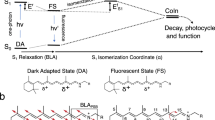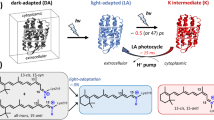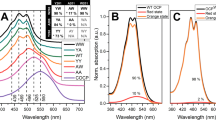Abstract
THE rate of the reaction between opsin and 11-cis retinal, that gives the visual pigment rhodopsin, is measured in the presence and absence of structural analogues of 11-cis retinal, the polyene side chain of which is varied systematically. A decrease in regeneration rate can be interpreted as competition with 11-cis retinal for the binding site on the protein. This approach seems to provide information on the molecular dimensions of the chromophore binding space of opsin. Rotmans noticed that all-trans retinal does not inhibit the reaction between opsin and 11-cis retinal leading to rhodopsin1. More recently Mastumoto and Yoshizawa2 have reported that β-ionone, a compound carrying the six-membered ring configuration of retinal but with a shorter side chain, does inhibit the rate of this reaction. The surprising discrepancy between these two observations has led us to study more systematically the effects on the regeneration rate of a number of 11-cis retinal analogues, in which either the polyene side chain or the aldehyde group has been modified. We report here results that suggest that opsin possesses a specific chromophore binding space, one dimension of which is determined by the longest axis of 11-cis retinal, measured from the hydrophobic binding site onwards.
This is a preview of subscription content, access via your institution
Access options
Subscribe to this journal
Receive 51 print issues and online access
$199.00 per year
only $3.90 per issue
Buy this article
- Purchase on Springer Link
- Instant access to full article PDF
Prices may be subject to local taxes which are calculated during checkout
Similar content being viewed by others
References
Rotmans, J. P. thesis, Univ. Nijmegen 89–91 (1973).
Matsumoto, H. & Yoshizawa, T. Nature 258, 523–526 (1975).
de Grip, W. J., Daemen, F. J. M. & Bonting, S. L. Vision Res. 12, 1697–1707 (1972).
Brown, P. K. & Wald, G. J. biol. Chem. 222, 865–877 (1956).
Hubbard, R., Brown, P. K. & Bownds, D. in Meth. Enzym. 18 c, 615–653 (1971).
Matsumoto, H., Horiuchi, K. & Yoshizawa, T. Biochim. Biophys. Acta 501, 257–268 (1978).
Wald, G. & Brown, P. K. Nature 177, 174–176 (1956).
Kropf, A., Whittenberger, B. P., Goff, S. P. & Waggoner, A. S. Expl Eye Res. 17, 591–606 (1973).
Honig, B. & Ebrey, T. A. Rev. Biophys. Bioengng 3, 151–177 (1974).
de Grip, W. J., Liu, R. S. H., Ramamurthy, V. & Asato, A. Nature 262, 416–418 (1976).
Matsumoto, H. & Yoshizawa, T., Vision Res. 18, 607–609 (1978).
Daemen, F. J. M. & Bonting, S. L. Biophys. Struct. Mech. 3, 117–120 (1977).
Author information
Authors and Affiliations
Rights and permissions
About this article
Cite this article
DAEMEN, F. The chromophore binding space of opsin. Nature 276, 847–848 (1978). https://doi.org/10.1038/276847a0
Received:
Accepted:
Published:
Issue Date:
DOI: https://doi.org/10.1038/276847a0
This article is cited by
-
Activation of phosphodiesterase by rhodopsin and its analogues
Biophysics of Structure and Mechanism (1983)
Comments
By submitting a comment you agree to abide by our Terms and Community Guidelines. If you find something abusive or that does not comply with our terms or guidelines please flag it as inappropriate.



